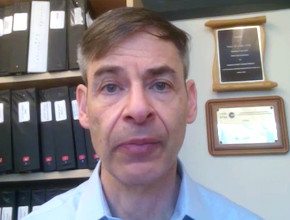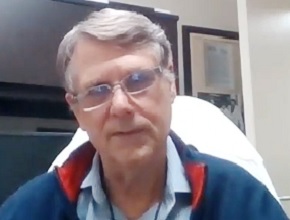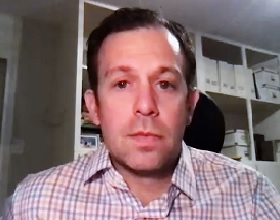Dr Mark Loeb, professor in the Department of Pathology and Molecular Medicine at McMaster University, joins Dr Roman Jaeschke to clarify the difference between droplets vs aerosols and surgical masks vs N95 respirators.
Roman Jaeschke, MD, MSc: Good afternoon, welcome to another edition of McMaster Perspective. I have the pleasure to reintroduce the section editor of infectious diseases in the McMaster Textbook of Internal Medicine and the section head of infectious diseases at McMaster University, Dr Mark Loeb.
Mark, I wanted to talk to you because I hear so much about things that I’ve never frankly paid much attention to, which are droplets, aerosols, and different masks. Why do you think people make it so important? What’s the reason that there is some sort of interest, if not controversy? The floor is yours.
Mark Loeb, MD, MSc: I think the particular interest is that there’s a belief—if we dichotomize these things—that “aerosolized” means that the particles will travel for very long distances, like they do in infections like measles, while if it’s a droplet, for example, then it becomes more like in other respiratory viruses, commonly like influenza, and the risk is only at a short distance.
But I think this sort of dichotomy is changing between droplets and aerosolized [particles] in terms of the aerosol science. Typically, traditionally or even currently—if you look at the World Health Organization (WHO) and probably Centers for Disease Control and Prevention (CDC) as well—there’s a distinction in terms of the size of the particles of 5 microns. In other words, particles larger than 5 microns are considered droplets and smaller than that are considered aerosols. The reality is that the distinction of these 5 microns, based on aerosol science, is probably incorrect. Likely, the difference is 10-fold. So it’s probably something like 50- or 60-micron particles that are the difference between large droplets and aerosols. There is evidence—again, it’s experimental evidence—from aerosol science that’s suggesting that there’s a range of particles and that our traditional distinctions are artificial and in fact they aren’t supported by evidence.
In fact, the aerosol scientists claim right now that they’re going back to the literature and they don’t even know how this distinction came about anyway, so perhaps there is unpublished data, or maybe there’s not. The aerosol scientists are saying that there’s not a clear distinction and that really when someone coughs or breathes there is a variety of sizes of particles. Some might be very large droplets and some might be aerosols, and aerosols to them are just defined by particles that float in the air.
I think it’s reasonable to look at that evidence, to look at that aerosol science. The real question is whether it really makes a difference to how we’re managing coronavirus disease 2019 (COVID-19) in the hospitals. I would say at this point within the health-care setting there’s not much that we would be doing differently, no matter how you conceptualize these 2 things, droplets versus aerosols.
Roman Jaeschke: So Mark, if I can summarize what you’ve said so far. There are droplets, which essentially fall with gravity to whatever surface there is, and there are aerosols, which float in the air. The distinction is rather in physical qualities than in the size. It sounds like the size is arbitrary—I’m thinking about the P value at the moment, which is another arbitrary value that had 5 in it [P < .05]—it sounds like there is 5 microns here as well and from what you’re telling us it’s artificial. So there's probably a whole range and continuum rather than dichotomy. What are the clinical implications which were to come from this observation in terms of spread of COVID-19 and in terms of what to do to avoid contact with this virus?
Mark Loeb: I think if we focus firstly on the health-care setting, it’s unclear what—if any—the clinical implications are, in that we know that most of the evidence, particularly in health care, is that transmission is occurring in short ranges, within a few feet. So whether this is large droplets or respiratory aerosols that are being spread over small distances, it’s really unclear. But that means that our way of dealing with it, which we call droplet precautions, and using medical masks when there are no aerosol-generating procedures—at least this is what we’re doing in Canada—there’s no clear evidence that that is incorrect.
There’s a controversy about whether we should be wearing medical masks or N95 respirators. The fact is that N95 respirators have a much better filtering capacity and will filter 95% of very small particles, because they’re tested with 0.3-micron particles, whereas [with] surgical masks there’s a very variable filtration, but we don’t really know what the meaning of this is in the hospital setting. There’s clearly a divergence of opinion among some aerosol scientists, who feel everybody should be wearing an N95 respirator, versus clinical epidemiologists, infection control physicians, who feel that in a non–aerosol-generating procedure setting—that is in routine care—medical masks are adequate.
A lot of these, let’s say, beliefs are driven by a person’s prior conceptions and training, but also the type of evidence that people place the most weight on is driven by their own training. For example, clinical epidemiologists, like you and me, will place a lot more weight on randomized controlled trials (RCTs) versus the aerosol biologists, who will place more weight on experimental designs, often with particles that aren’t even infectious in the first place.
Roman Jaeschke: Let me play the devil’s advocate, and I will provide the first part of the answer to my question. Why not give everybody N95 respirators? That is the question and my first part of an answer is, working in the intensive care unit, I can survive the day with a surgical mask, but there is almost no way I could wear the N95 for several hours in continuum. That’s my first answer. There is a drawback of N95 for everybody for all the time. Are there any others you can think of?
Mark Loeb: Well, there are a number of factors. Firstly, there’s the supply chain. Access to N95 respirators, I would say, across the world is still very limited, so if we’re going to preserve N95 respirators, we would rather do this when health-care workers are in a high-risk situation.
That is one reason, and you mentioned the possibility of noncompliance: people not having been able to use an N95 respirator for long periods of time because of discomfort, because of headaches. Some people have bruising, etc.
My view on the whole thing, though, is that for example in medicine, when we look at interventions… even if we take infectious diseases, when we’re looking at vaccines, we do RCTs to tell us whether a vaccine is effective or not, right? We don’t rely only on preclinical data, we don’t rely on experimental data that hasn’t been tested in people. Based on that, I would use the same philosophy about medical masks. These are devices that are made to protect people and can have important implications, right? Similar to a vaccine in that if you’re not wearing the right face mask, it might lead to infection. That’s why I feel that the best strategy is to do a RCT between the N95 respirators and medical masks in a relatively low-risk setting, which is what we’re doing now at McMaster. We’re leading a trial in Canada and internationally to address this question.
Roman Jaeschke: So, to summarize, because we both work in clinical areas, we still both feel comfortable using surgical masks outside the specific aerosol-generating procedures and we are comfortable advising others to do so unless and until we have the better data to the contrary, especially if this contrary data would favor an intervention that is less convenient, more costly, and less accessible at the moment. Is that your view as well?
Mark Loeb: Yeah, that’s correct, Roman, and it’s not based on nothing. It’s also based on systematic reviews of RCTs that at this point don’t show—they’re not severe acute respiratory syndrome coronavirus 2 (SARS-CoV-2), they’re influenza and other respiratory viruses—really don’t show a significant difference between N95s and medical masks. It’s true that for some of these trials the confidence intervals are wide and SARS-CoV-2–specific RCTs should be done, but the best evidence is not suggestive of risk with not using the N95 respirator.
Roman Jaeschke: There’s still equipoise.
Mark, since I have you here, any comment about covering of the eyes with glasses, visors, or goggles?
Mark Loeb: Yes, there’s observational data. Again, it’s led by studies done at McMaster that suggest that covering the eyes with face masks or goggles has a substantial reduction. Again, this is not necessarily based on SARS-CoV-2 data. It’s based on severe acute respiratory syndrome (SARS) and Middle East respiratory syndrome (MERS) data, but that’s [what it’s] suggesting. I’m not aware of any RCTs, however, in this area.
Roman Jaeschke: Well, with the lack of anything better we will wear the mask, at least the surgical mask, we will keep the distance of at least a meter if not better 2, and we will try to keep something in front of our eyes, whether glasses, goggles, or shields. Is that reasonable advice for the moment?
Mark Loeb: Yes, I think that’s very reasonable advice and it takes into account the best evidence that’s currently available.
Roman Jaeschke: Thank you very much. We’ll keep watching for new evidence and we’ll summarize it for our listeners if it becomes available. Thank you very much, Dr Loeb, for your time.
Mark Loeb: You’re very welcome.
 English
English
 Español
Español
 українська
українська











